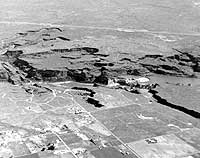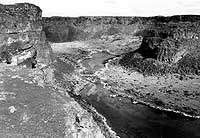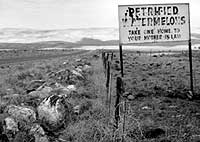|
Page
165
|
Rock
Creek Store and Stricker Ranch
The Oregon
Trail, and, in the 1860s, the Kelton, Utah to Boise, Idaho freight road, crossed
Rock Creek about 6 miles south of what is now Hansen. This crossing avoided
the deep canyon of Rock Creek to the north. The Rock Creek Store was built on
this site in 1865, and purchased by Herman Stricker in 1876. After the closure
of Fort Hall in 1856, this was the only place on the Snake River Plain where
provisions could be purchased east of Fort Boise. The Stricker family lived
here for almost 100 years and served travelers,miners, dam construction personnel,
and ranchers. The site and original buildings have been preserved by the Friends
of Stricker Ranch, Inc., P.O.Box 2218, Twin Falls.
 |
 |
 |
|
(left) Aerial view of Twin Falls and alcoves where the Lake Bonneville Flood emptied back into the Snake River. Note the lack of soil on the northside of the river where it was all eroded by the flood, (June, 1990). (center) Blue Lakes Alcove and spring-fed lake, looking north. Alcove was cut during the Lake Bonneville Flood, 14,500 years ago, (March,1993). (right) Road sign near King Hill, west of Twin Falls, (October,1990). The petrified watermelons are boulders of basalt moved by the Lake Bonneville Flood about 14,500 years ago. The sign reads: "Petrified Watermelons, Take one to your mother-in-law." |
||
The
Carey Act and Milner Dam
Ira Burton
Perrine spearheaded the construction of Milner Dam and the Twin Falls project
which was completed in 1905. At the time this was the largest privately financed
irrigation project in the world. The Magic Valley lived up to its name and boom
towns sprang up. This boom was directly caused by the availability of irrigation
water. Investors (Wendell and Jerome Hill, Buhl, Hansen, Milner) in Perrine's
scheme got towns named for them.Other towns founded after construction of the
Twin Falls project included Kimberly, Filer, Hazelton and Eden.
In 1905, the rail line was finished to Twin Falls and on to the end of the branch at Buhl. By the end of the year, Twin Falls had a bank, doctor,attorney, dentist, barber, school, newspaper, restaurant and rooming house.
Sheep
and Cattle Grazing
Cattle
boomed in central Idaho in the late 1870s. Sheep came later, and the Idaho woolgrowers
organized in 1893. Future governor Frank R. Gooding was president and the sheep
industry held great political power in the early 20th century. As with other
western rangelands, bitter conflict between sheepherders and cowboys ensued.